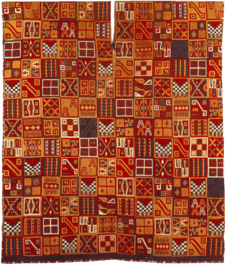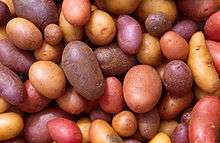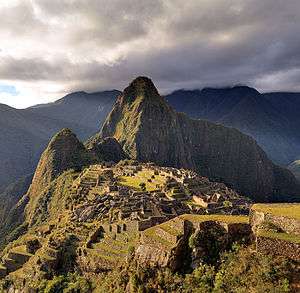Inca society
The Inca society was the society of the Inca civilization in South America. The Inca Empire, which was centred in what is now called Peru, Bolivia, Ecuador and southern Colombia and lasted from 1438 to 1533 AD, represented the height of this civilization. The Inca state was known as the Kingdom of Cusco before 1438. Over the course of the Inca Empire, the rulers used conquest and peaceful assimilation to incorporate in their empire a large portion of western South America, centred on the Andean mountain ranges. The empire proved relatively short-lived however: by 1533, Atahualpa, the last Sapa Inca (emperor) of the Inca Empire, was killed on the orders of the conquistador Francisco Pizarro, marking the beginning of Spanish rule. The last Inca stronghold, the Neo-Inca State in Vilcabamba was conquered by the Spanish in 1572.
Population
Population estimates for the Tawantinsuyu society range from as few as 9 million people to more than 37 million. The reason for these various estimates is that, despite that the Inca kept excellent census records using their quipus, knowledge of how to read them has been lost. Almost all of them were destroyed by the Spanish in the course of their conquest.[1]
Marriage
Incan women were typically married at the age of sixteen. But men married at the age of 20. In Inca society, due to economic regulations, men of lower rank could only have one wife. The aristocracy, starting with the curaca, were allowed to engage in polygamy.[2]
Trial marriages were typical within Inca culture. In this type of marriage, the man and woman would agree to try out being married to one another for a few years. At the end of this time, the woman could go home to her parents if she wished, and her husband could also send her home if he did not think it would work out. However, once the marriage was made final, they could only divorce if the woman was childless.
Women would almost always marry men in the same social class as themselves. However, while it was very rare for them to marry a man with a higher social ranking, it was still possible for some young women. The only way for a young woman to alter her social ranking would be if a man of higher ranking took notice of her.
In the Inca society, a wedding was not a joyous celebration. Instead, it was looked at more as a business-like agreement. Therefore, for the Inca, marriage was an economic agreement between two families. Once a woman was married, she was expected to collect food and cook, watch over the animals and the children. A woman’s household obligations would not change after she became pregnant. When she did find out she was pregnant she prayed and made offerings to an Inca god, Kanopa
Arts
The Inca were a conquering society, and their expansionist assimilation of other cultures is evident in their artistic style. The artistic style of the Inca utilized the vocabulary of many regions and cultures, but incorporated these themes into a standardized imperial style that could easily be replicated and spread throughout the empire. The simple abstract geometric forms and highly stylised animal representation in ceramics, wood carvings, textiles and metalwork were all part of the Inca culture. The motifs were not as revivalist as previous empires. No motifs of other societies were directly used with the exception of Huari and Tiwanaku arts.
Shipbuilding
For fishing, trade, construction, transport and military purposes, the Inca built seagoing vessels called balsas by weaving together totora reeds. The largest of these vessels were 20 to 30 meters long, making them comparable in length to Spanish Caravels . This method of constructing ships from woven reeds is an ancient Peruvian tradition which long predates the Inca. There are depictions of such vessels in Moche pottery dating back to 100 A.D.
Clothing

Inca officials wore stylized tunics that indicated their status. It contains an amalgamation of motifs used in the tunics of particular officeholders. For instance, the black and white checkerboard pattern topped with a pink triangle is believed to have been worn by soldiers of the army. Some of the motifs make reference to earlier cultures, such as the stepped diamonds of the Huari and the three step stairstep motif of the Moche.
Cloth was divided into three classes. Awaska was used for household use, and usually made from llama wool. Finer cloth, qunpi, was divided into two classes: The first, woven by male qunpikamayuq (keepers of fine cloth) from alpaca wool, was collected as tribute from throughout the country and was used for trade, to adorn rulers and to be given as gifts to political allies and subjects to cement loyalty. The other class of qunpi ranked highest. It was woven in the Acllawasi (acllahuasi) by "aclla" (female virgins of the sun god temple) from vicuña wool and used solely for royal and religious use. These had thread counts of 300 or more per inch, unsurpassed anywhere in the world, until the Industrial Revolution of the 19th century.
Aside from the tunic, a person of importance wore a llawt'u, a series of cords wrapped around the head. To establish his importance, the Inca Atahualpa commissioned a llawt'u woven from vampire bat hair. The leader of each ayllu, or extended family, had its own headdress.
In conquered regions, traditional clothing continued to be worn, but the finest weavers, such as those of Chan Chan, were transferred to Cusco and kept there to weave qunpi. (The Chimú had previously transferred these same weavers to Chan Chan from Sican.)
The Incan government controlled all clothing of their society. One would receive two outfits of clothing, one formal and one casual pair, and they would then proceed to wear those same outfits until they could literally be worn no longer. Since the government was in such strict control on their clothing, the Incas could not alter their clothing without the permission of the government.
Jewelry
The wearing of jewelry was not uniform throughout the empire. Chimú artisans, for example, continued to wear earrings after their integration into the empire, but in many other regions, usually only local leaders wore them.
Ceramics and metalwork
_01.jpg)
Ceramics were for the most part utilitarian in nature, but also incorporated the imperialist style that was prevalent in the Inca textiles and metalwork. In addition, the Inca played drums and on woodwind instruments including flutes, pan-pipes and trumpets made of shell and ceramics.
The Inca made beautiful objects of gold, silver, copper, bronze and tumbaga . But precious metals were in shorter supply than in earlier Peruvian cultures. The Inca metalworking style draws much of its inspiration from Chimú art and in fact the best metal workers of Chan Chan were transferred to Cusco when the Kingdom of Chimor was incorporated into the empire. Unlike the Chimú, the Inca do not seem to have regarded metals to be as precious as fine cloth. Nonetheless, the metalworks of the Incas were perhaps the most advanced in America. When the Spanish first encountered the Inca they were offered gifts of qunpi cloth. Incan ceramics are usually very distinct and easy to recognize. The shapes of the vessels are highly standardized. The most typical Incan pottery would have a spherical body with a cone shaped base. This spherical body usually includes two vertical side handles with a tall neck and flaring rim. The Incans often would place animal heads on their pottery as well usually near the top of the vessel. There were also several other popular styles for Incan ceramics which included a shallow dish with a single bird head and handle, a pedestal beaker, and a single or double handled bottle.
Incans often decorated their ceramics with a multitude of images and colors. They usually decorated their pottery with bright colors of red, yellow, orange, black and white. Much like all other forms of Incan art, the pottery was often decorated with geometric shapes. The Incans would put diamonds, squares, checkers, triangles, circles and dots on almost all of their ceramic work. Other common themes were animals and insects like llamas, birds, jaguars, alpacas, bees, butterflies as well as block-like humans.

As part of a tax obligation to the commoners, mining was required in all the provinces. Even though the Inca Empire contained a lot of precious metals, the Incans did not value their metal as much as fine cloth. The Incans adopted much of their metal-working characteristics from the metalwork of Chimu. Because of their expertise in metalworking, after the fall of Chimu many metalworkers were taken back to the capital city of Cuzco to continue their metalworking for the emperor. Copper, tin, gold, and silver were all obtained from mines or washed from the river gravels. These metals would then be handed over to metallurgists. Because the Inca had a system that emphasized political and religious organization, there were many specialized artisans like metallurgists. There were also specialized weavers, cloth makers, pottery makers, and many more. Both copper and bronze would be used for basic farming tools or weapons. Some of the common bronze and copper pieces found in the Incan empire included sharp sticks for digging, club-heads, knives with curved blades, axes, chisels, needles and pins. All of these items would be forged by a metallurgist and then spread throughout the empire.
The Incans reserved their more precious metals for ornaments and decorations. Gold, magnesium and silver were common themes throughout the palaces of Incan emperors. It was said that the walls and thrones were covered with gold and that the emperor dined on gold and silver service. These golden plated services would often be inlaid with llamas, butterflies or other creatures. Even beyond the gold and decoration of the emperor’s palace were the ornaments that decorated all of the temples throughout the empire. The temples of the Incans were strewn with sacred and highly precious objects. Headdresses, crowns, ceremonial knives, cups, and a lot of ceremonial clothing were all inlaid with gold or silver.
Many historians believe that the choice of gold was to distinguish the more “sacred” or “holy” pieces from others. The commonality of gold has much to do with the Incan religion surrounding the sun. Because of the beautiful reflection that gold casts, it gave the appearance of containing the sun, making the precious metal even more valued in a sun-obsessed society. Gold was reserved for the highest class of Incan society which consisted of priests, lords and of course the Sapa Inca or emperor.
Education

The Inca used quipu or bunches of knotted strings, for accounting and census purposes. Much of the information on the surviving quipus has been shown to be numeric data; some numbers seem to have been used as mnemonic labels, and the color, spacing, and structure of the quipu carried information as well. Since it isn't known how to interpret the coded or non-numeric data, some scholars still hope to find that the quipu recorded language.
The Inca depended largely on oral transmission as a means of maintaining the preservation of their culture. Inca education was divided into two distinct categories: vocational education for common people of Inca and highly formalized training for the nobility.
Religion
The belief system of the Incas was polytheistic. Inti, the Sun God, was the most important god, which the Incas believed was the direct ancestor of the Sapa Inca, the title of the hereditary rulers of the empire.
Other practices
The Inca practiced cranial deformation. They achieved this by wrapping tight cloth straps around the heads of newborns in order to alter the shape of their still-soft skulls. These deformations did not result in brain damage. Researchers at the Field Museum believe that the practice was used to mark different ethnicities across the Inca Empire.[3]
Food and farming

It is estimated that the Inca cultivated around seventy crop species. The main crops were potatoes, sweet potatoes, maize, chili peppers, cotton, tomatoes, peanuts, an edible root called oca, and the pseudograins quinoa and amaranth. The crops developed by the Inca and preceding cultures makes South America one of the historic centers of crop diversity (along with the Middle East, India, Mesoamerica, Ethiopia, and the Far East). Many of these crops were widely distributed by the Spanish and are now important crops worldwide. Salsa was originated by the Inca people using tomatoes, chili peppers, and other spices.
The Inca cultivated food crops on dry Pacific coastlines, high on the slopes of the Andes, and in the lowland Amazon rainforest. In mountainous Andean environments, they made extensive use of terraced fields which not only allowed them to put to use the mineral-rich mountain soil which other peoples left fallow, but also took advantage of micro-climates conducive to a variety of crops being cultivated throughout the year. Agricultural tools consisted mostly of simple digging sticks.

The Inca also raised llamas and alpacas for their wool, meat, and to use them as pack animals and captured wild vicuñas for their fine hair.
The Inca road system was key to farming success as it allowed distribution of foods over long distances. The Inca also constructed vast storehouses, which allowed them to live through El Niño years while some neighboring civilizations suffered.
Inca leaders kept records of what each ayllu in the empire produced, but did not tax them on their production. They instead used the mita for the support of the empire.
The Inca diet consisted primarily of fish and vegetables, supplemented less frequently with the meat of cuyes (guinea pigs) and camelids. In addition, they hunted various animals for meat, skins and feathers. Maize was malted and used to make chicha, a fermented alcoholic beverage.
Economy
According to Ferreira and Chamot:
- "The social system of the Incas had an ancient Andean origin based on the ayllu, an extended family group with a common ancestor. The economic system was also based on ancient social structures and can be explained through several principles, namely reciprocity, redistribution, and vertical control."
These authors also add:
- "Redistribution, a practice employed by the state, ensured that all agricultural goods not exchanged by reciprocity were to be distributed in the different areas of the empire in the case of bad crops."[4]
In essence, the government of the Inca functioned as a safeguard against mass starvation.
References
- ↑ McEwan, Gordon Francis (2006). The Incas: New Perspectives. W. W. Norton. pp. 93–96. ISBN 0-393-33301-9. There is some debate about the size of the population.
- ↑ Incas: lords of gold and glory. New York: Time-Life Books. 1992. p. 130. ISBN 0-8094-9870-7.
- ↑ Machu Picchu: Ongoing Investigations
- ↑ Darget-Chamot, Ferreira '''Cultures and Customs of Peru; Greenwood Press; Westport Ct/London; 2003; pp 13
External links
- Inca Architecture
- Inca civilization and other ancient civilizations.
